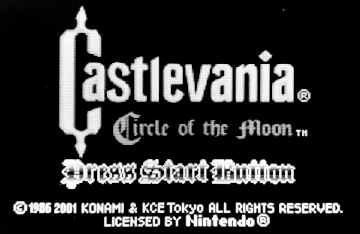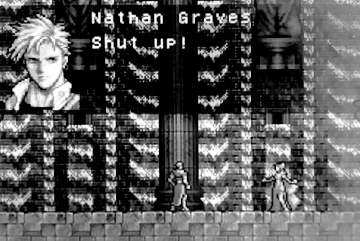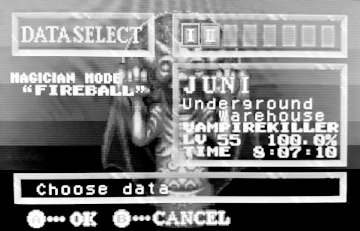Igavanias are a niche of games I've never had an interest in. More accurately, I'd never had much of an interest in Castlevania at all. Simon Belmont was an iconic mascot of video gaming in my eyes, about on par with Mega Man, Sonic, and Mario. Despite the accolades, and plenty of coverage of early 00's advertising for the series, Castlevania as a franchise just never piqued enough interest within my head to want to buy any of them. Castlevania remained a mainstay in my gaming lexicon, but only in knowledge of Castlevania existing, being old, and in my understanding, being an iconic mascot franchise of 80s and 90s gaming.

Following Symphony of the Night, Circle of the Moon in retrospect seems like a potential branching path the Castlevania franchise could have progressed down. Circle of the Moon was a distinctly different experience from Symphony, the swap in directors can really be felt in this game.
I don't want to discuss either Symphony or Harmony of Dissonance too much, because the scope of those games certainly make them deserving of their own focus, rather than being tangential reference poitns. However I feel both of these games must be mentioned to truly understand Circle of the Moon in retrospect.
As a hypothetical statement being made, if somebody were to claim "Symphony of the Night showed that Castlevania could work as an exploration focused action-RPG-platformer hybrid," I do not feel this statement would draw much discussion or disagreement. Because in 2025, we (gamers, broadly speaking) understand the Castlevania to be a broad multi-genre franchise across numerous sub-series. Within the context of 1997, Castlevania was a franchise that consisted of several action-platformers. Symphony of the Night was not re-contextualizing the Castlevania that came before it within a new genre. Rather Symphony of the Night built a new understanding of what Castlevania is from the ground up. In 2025 we understand Symphony of the Night to be the first Igavania, the first Castlevania game in this style directed by Koji Igarashi.
Circle of the Moon took the established foundation of Symphony of the Night and superimposed the older understanding of Castlevania onto it. At a surface level, projecting old Castlevania traits onto the formula Symphony established may seem a bit superficial. At its core, Circle of the Moon is still using the Symphony template, but some of these changes in practice caused much bigger gameplay ramifications than what a paper design document may suggest.
Alucard wields many weapons and has an expanded, more fluid moveset than a Belmont has ever had. Nathan wields exclusively a whip and controls with a stiff precision harkening back to Simon. Symphony featured many weapon and armor drops that drastically altered how Alucard could approach combat and platforming. Nathan is simply left to his whip and classic subweapons, and enemy item drops are essentially just damage modifiers.
While Symphony also focused on having sprawling maps consisting of very few platforming challenges, with a primary focus on enemy placement to create combat challenges. Classic Castlevania also featured plenty of flat hallways with enemy placement and combat being the only challenge. However the difference is mostly that the combat was left simple in Circle of the Moon. Simon and previous Belmonts had to use careful movement and jumping to compensate for their limited offensive arsenal. Meanwhile Symphony Alucard had such a breadth of movement and attacking options that you're always in the full control. In Symphony you get to engage and fight the enemy on your own terms, but in classic Castlevania vein you're using your platforming toolkit to dodge and defeat the enemy in traditional platformer fashion.
With these expressions stated, I enjoyed playing Circle of the Moon immensely. The difficulty level in Symphony I found to be a bit low, mostly because of how many tools the game gives you to completely overwhelm foes. In Circle the enemy damage output felt extremely high, while Nathan didn't have the tools to just trivialize each enemy as they spawned on screen.
Circle of the Moon's DSS system provided many fun options, but I don't particularly care for how it was presented. DSS cards are your only combat option outside of the basic whip and subweapons. From adding elemental affinities to your whip, giving you defensive properties against specific elements, to letting you item crush and summon. A lot of options are gained from DSS, but since you can only use one option from a pair of cards at a time, these DSS options supplement the primary toolkit of whip and subweapons, rather than replace them. The issue is mostly in the drop rates on these cards are very low. I like the idea on paper of only having DSS options based on what randomly drops, but in my playthrough I only had a total of 5 out of 20 drop, and none of the card options I created gave me particularly fun or impactful options. The best I was able to do was adding extra damage to my whip for enemies weak to fire, or just baseline increasing my STR stat. Fortunately there's a very easy to abuse glitch that allows you to access the entire DSS card pool once you have access to a single valid pair. When you activate your DSS combo, during the spell cast animation if you pause the game and swap the cursor location on the DSS cards to the spots of cards you haven't currently acquired, your spell cast will instead cast based off this new cursor location. Since DSS spells remain active until manually cancelled (although you can only have one active at a time), this is a very quick and painless glitch to perform. I started abusing this glitch about halfway through my playthrough and it actively made me have more fun with the game. I felt like I got to engage with the most interesting mechanic and could use more strategy and planning for how to tackle sections of particuarly tough enemies.

The DSS spells I just don't think are generally impactful enough to drive how your playthrough functions. They're mostly element specific buffs and attacks, so what they're effective against changes so much during the course of the game. You won't end up with different builds of Nathan that actively have different gameplay strategies for the game based on what DSS cards you have access to. Ala you're not going to be playing a ranged build vs melee build vs magic build vs etc. You're going to be playing the same classic Belmon gameplayt, but have different stat boosts or defensive attributes based on what DSS combo you have active.
The game tried to promote the idea of having radically different playstyles with the unlockable game modes. Magician mode starts you with every DSS card. Fighter mode gives a huge boost to all your stats but you don't have access to DSS at all. Gradius mode gives you additional hearts and an exclusive subweapon. Thief mode lowers your stats except luck which gets a huge boost, so all enemy drops are more frequent, which includes DSS cards.
On paper these game modes all sound cool, and I do think they're fun. But they feel more like playing the game with stat alterations rather than a radically different experience. Magician mode plays like what I think the first playthrough should be, except Nathan is way more fragile and a hard game is made even harder. Fighter mode is by far the easiest because it makes you strong enough that enemies don't feel like much of a threat. Gradius mode feels pointless because I used the cross constantly in normal gameplay and the homing dagger feels so much weaker in comparison. And thief mode just feels like having heavily reduced stats but drop rates finally become reasonable.
I really enjoyed the map design of Circle of the Moon as well. I've gotten so used to this style of 2D-exploration action games preferring to have massive sprawling maps. Maps where connections between areas only happen within clearly designated transitional hallways. Circle of the Moon felt refreshing by having the map be very compact, letting two areas touch on the map side by side and having the entire transition just be a single door, sans hallway. Without needing to have the transitional hallways and more dividing space between area, it lets the map feel very dense, where connections between areas can happen almost anywhere. It made me a lot more interested in exploring and looking for secrets on the map. Any time I looked at the map and saw a bit of space where it was a void, I just assumed there was a secret door there, and was almost always right in that assumption. I felt like there was always stuff going on in the map and I was rarely just in a designated linear hallway full of enemies.
The arena was a slightly weird addition to me. In a game that actively wanted to reduce combat options compared to Symphony, for a greater emphasis on platforming, having a dedicated combat gauntlet seems a bit counterproductive. As you enter, your magic is entirely drained preventing the use of DSS as well. So you're restricted to just your whip and subweapons, even further emphasizing the most basic form of combat in the game. Fortunately the arena is so long, and enemies deal such high amounts of damage, that it ends up being a grueling trial to get through the entirity of the arena. This was a very fun trial of endurance and test of enemy pattern comprehension, at a difficulty level that I'm still left in awe over for the main game.
After finally giving Circle of the Moon the proper time of day, I'm honestly left significanlty more interested in the later Castlevania franchise. I wish I had played this game sooner because I feel like a lot of my misconceptions on what an Igavania was were brushed away, specifically because the new staff for this game weren't simply trying to create Symphony 2. Overall an excellent game.
— Juni - April 28th, 2025 —

